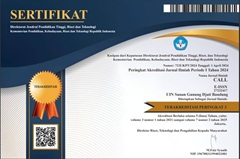COMPARATIVE STUDY ON THE INTRINSIC ELEMENTS OF THE HOBBIT NOVEL AND MOVIE SCRIPT
DOI:
https://doi.org/10.15575/call.v1i1.8805Abstract
This research analyzes the comparison of intrinsic elements in the novel and the movie script The Hobbit. this work tells about unexpected adventures. A long journey is one of man's biggest dreams. Break away from the comfort of life, explore the uncharted world, without a definite purpose and guarantee a safe return. This is what make decided them Bilbo, Gandalf, and thirteen Dwarves to meet Smaug, the giant dragon inhabiting the Silent Mountain. In this research, researchers used the Racmat Ddjoko Pradopo theory. Pradopo explained that structuralism is a structure with elements that are closer and every element that has meaning in relation to other elements. The researcher used the comparative method because the object under study was a comparative literary work. In analyzing the data, the researcher analyzed the quotes in the novel that were in accordance with the topic and also the theory used. This study aims to analyze the similarities and differences in intrinsic elements in the novels and scripts of the film The Hobbit. it can be seen that the intrinsic element plays an important role in building the story so that it is conveyed by the reader.
Keywords: The Hobbit, Structuralism, Intrinsic Elements, Comparative Studies,
Similarities and Differences.
Downloads
Published
Issue
Section
Citation Check
License
Authors who publish in CALL agree to the following terms:
- Authors retain copyright and grant the journal right of first publication with the work simultaneously licensed under Attribution-ShareAlike 4.0 International (CC BY-SA 4.0) License that allows others to share the work with an acknowledgment of the work's authorship and initial publication in this journal.
- Authors are able to enter into separate, additional contractual arrangements for the non-exclusive distribution of the journal's published version of the work (e.g., post it to an institutional repository or publish it in a book), with an acknowledgment of its initial publication in this journal.
- Authors are permitted and encouraged to post their work online (e.g., in institutional repositories or on their website) prior to and during the submission process, as it can lead to productive exchanges, as well as earlier and greater citation of published work (See The Effect of Open Access).




